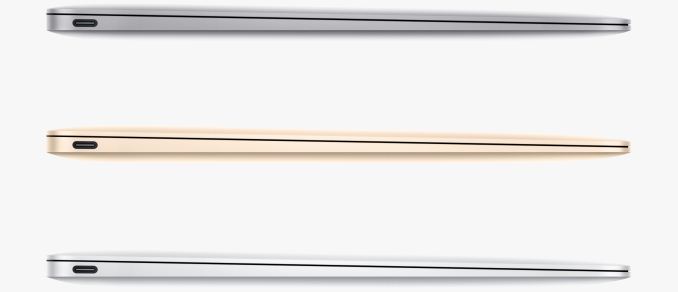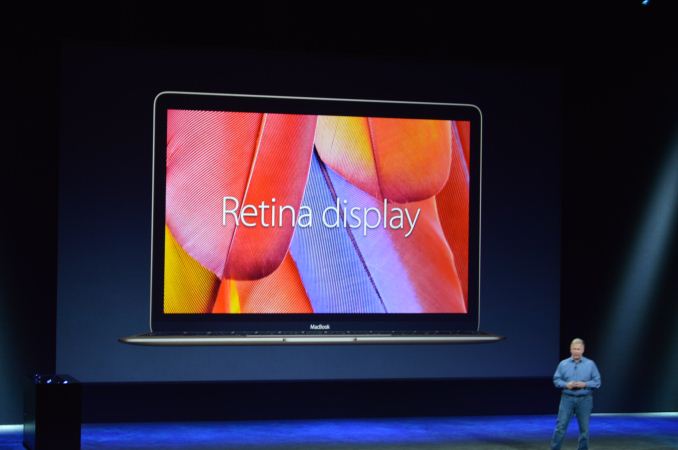Apple Announces The New MacBook (2015)
by Brandon Chester on March 9, 2015 4:30 PM EST
Today Apple announced a brand new MacBook laptop. This new laptop doesn't fall under Apple's existing MacBook Pro and MacBook Air categories, but is instead simply called the MacBook. In truth, this is actually more like the return of an old name that hasn't been seen in some time, rather than the creation of a new product line. When the MacBook Air was introduced, consumers overwhelmingly chose it over the original MacBook line. It eventually absorbed that category of Apple's laptops, while the Pro line remained for users who needed something with more processing power.
| The New MacBook | |
| Dimensions | 28.05 x 19.65 x 0.35–1.31cm |
| Mass | 920g |
| CPU | Intel Core M-5Y70 or M-5Y71 |
| L3 Cache | 4MB |
| Base CPU Clock | 1.1GHz or 1.2GHz |
| Max CPU Turbo | 2.9GHz |
| GPU | Intel HD Graphics 5300 |
| System Memory | 8GB 1600MHz LPDDR3 |
| Storage | 256GB or 512GB PCI-E SSD |
| Display | 12" 2304x1440 IPS LCD |
| Battery | 39.7Wh |
| Ports | 1 x USB Type-C, 3.5mm combo jack |
| Connectivity | 2x2 802.11a/b/g/n/ac + BT 4.0 |
| Price | $1299 or $1599 |
This new MacBook was recently rumored, and there have been many different reactions from Apple fans and tech press alike. It's certainly a departure from even the existing MacBook Air, and in many ways it seems more fitting of the Air name than the current Air does. Apple's goal was clearly to make something thin, light, and almost appliance like. They've certainly succeeded, but in order to get there the MacBook makes some big changes to what is currently thought of as a notebook.
The biggest change is to physical connectivity. Macs currently come with a couple of USB ports, a couple of Thunderbolt 2 ports, a 3.5mm jack for audio, and some connector for power. The new MacBook goes in a completely different direction, ditching every single legacy port with the exception of the 3.5mm jack. Instead, the MacBook has a single USB Type-C port on the left side, and this port is the only method of connecting with other devices, as well as charging. It's a huge departure from the current MacBooks and laptops in general, and only time will tell how well consumers respond to this change.
Apple's pursuit of thinness also necessitated changes to the input devices when compared to other MacBooks. With a slimmer chassis comes less space for the key switches underneath the key caps. In order to make the keyboard on the new MacBook, Apple designed a new type of key switch which they are calling a Butterfly Switch. This new switch is 40% thinner than the scissor switches used on older MacBooks, and it eliminates the wobble that occurs when pressing on the edges of scissor switches. The trackpad has also been redesigned to use Apple's Force Touch technology from the Apple Watch. which allows the user to press anywhere on the trackpad to click, and gives a haptic response to presses. It can also determine the force of a press to perform gestures or other actions. Both of these changes are interesting, but they do make large changes to the feel of the keyboard and trackpad. Key travel distance has certainly been reduced, and the new trackpad won't have the clickiness of the old ones. It will be interesting to see how consumers react to these changes.
Apple's other goal seems to have been making the new MacBook fanless. In order to do so, the new MacBook utilizes Intel's new Core M processors. The starting configuration at $1299 uses Core M-5Y70 which has a base frequency of 1.1GHz and a turbo frequency of 2.9GHz. The 1.2GHz Core M-5Y71 is available in the $1599 model, and a 1.3GHz version is available as a build to order option on Apple's online store. All models come with 8GB of LPDDR3 memory standard.
Like all of Apple's recent products, the new MacBook comes with a Retina display. This is a 12" 2304x1440 IPS display, which equates to 226 pixels per inch. While this new MacBook is not a MacBook Air, it's good to see the thin and light laptop in Apple's line finally moving both to a high resolution display as well as to an IPS panel. Assuming that Apple does the same 2x scaling that they've used in all of their other products, users will be given a desktop with the same area as a 1152x720 display which is actually slightly lower than the 11" MacBook Air. Apple specifies that the scaled resolutions available are 1440x900, 1280x800, and 1024x600, although it remains to be seen how well Intel's HD 5300 will keep up when rendering at 2880x1800 offscreen for the 1440x900 scaled mode.
This new MacBook reminds me a lot of the iPad. It has a port for charging and for interfacing with other devices via adapters, and a port for your headphones. Everything else is meant to be done wirelessly, and there's certainly no room for user upgrades or repairs. It's very much an appliance-like computer, and it's something very different from any laptop Apple has ever done before. I naturally want to feel skeptical about it, but the MacBook Air was an equally dramatic shift from the norm when it was first introduced, and it eventually replaced the original MacBook line entirely. Whether or not the changes in the new MacBook become common among future laptops is up to consumers. If you want to be one of the first people to enter uncharted territory with this new MacBook, it'll be available in just over a month, on April 10.












119 Comments
View All Comments
artemicion - Monday, March 9, 2015 - link
Gorgeous laptop. Not for me though. I've always been a cheap and functional giant Eastpak backpack type of guy, and this new Macbook is clearly targeting the Louis Vuitton svelte form over function crowd.eanazag - Monday, March 9, 2015 - link
I am happy to see 16x10 screen. I really hope we see PCs copy that. I'd be impressed if audio doesn't totally suck.I'm confused how the web browsing battery life is shorter than video playback. Both numbers are good. Better than my iPad 4.
Fanless! The next Surface Pro must be fanless. I don't know why people were knocking the processor. It would be the same people praising it in a PC. It is not Atom.
Aidic06 - Monday, March 9, 2015 - link
Think it mainly comes down to most of the process of watching a movie is done at the hardware level now. The iGPU can decode and run the display while the CPU sleeps and no wifi radio traffic (or very little, depending on background apps and services). While most of the things you use while web browsing rely on using the wifi radio, which is much less efficient, and the cpu has to work a little more.basroil - Tuesday, March 10, 2015 - link
"While most of the things you use while web browsing rely on using the wifi radio, which is much less efficient, and the cpu has to work a little more."Actually all depends on the OS and how it partitions requests. In the case of Windows 8.1, web (without flash ads all over the place) is just as efficient if not more efficient than video because any normal program (with than Chrome) will do a "hurry up and wait" method, allowing the CPU to be asleep most of the time. With Intel graphics and an eDP1.4 display, it's taken one step further by allowing the GPU to sleep until something changes, and even then it'll only redraw what has changed rather than the whole screen. Video also gets the same treatment, but you're only really trading some CPU for ASIC time, so the only real impact is WiFi. But for most cases WiFi shouldn't be too much of an issue, perhaps they had to boost the signal strength due to the chassis design (like iPhones, which had short talk times because of it)
Calista - Monday, March 9, 2015 - link
Still, for many a task (not all) a Bay Trail CPU will performance quite well compared to Core M. Not faster, but not far behind either. Bay Trail is no longer the N270 of yesteryear.kyuu - Monday, March 9, 2015 - link
Nobody has praised Core M in PCs. It's been pretty universally panned as significantly less powerful than Haswell ULVs, largely due to low clock speeds and significant throttling in the power and thermally constrained devices it's being used in. I'm curious to see if Apple has managed to prevent throttling issues given the lack of a fan and being stuffed into such a thin device packed to the brim with battery. I would bet not.That said, I would expect to see Core M in a Surface Pro refresh, but I hope they keep the fans to prevent throttling. It's not like they can't be kept off when they're not needed.
fokka - Monday, March 9, 2015 - link
i think you can bet your ass a core m surface pro will be fanless.Azurael - Thursday, March 12, 2015 - link
Dell's new Venue 11 Pro is Core M-based and fanless too...Still, I don't really 'get' it to be honest. I have the previous Venue 11 Pro with a Y-series haswell chip, and the fan only comes on when running a game for a substantial amount of time. I would have thought it would be better to have a "99%" fanless device that can deliver the goods when needed than something that's just going to throttle harder the more you push it...
Aenean144 - Tuesday, March 10, 2015 - link
It depends on the browsing test. Intel is quite optimized for race-to-sleep, active idle etc, so the CPU spends most of the time in a sleep state for web browsing. For video playback, that hardware is always running.Overall, the runtime tests for these 5 W SoC with bigger displays are really just tests of how efficient the display is. It's biggest power user. Saving power on the SoC side is hitting diminishing returns with the aforementioned race-to-sleep stuff.
lilmoe - Monday, March 9, 2015 - link
It is great looking. But does "too thin" make any sense? I think it's too thin for me. The practicality factor is down the drain as well with that huge number of ports.